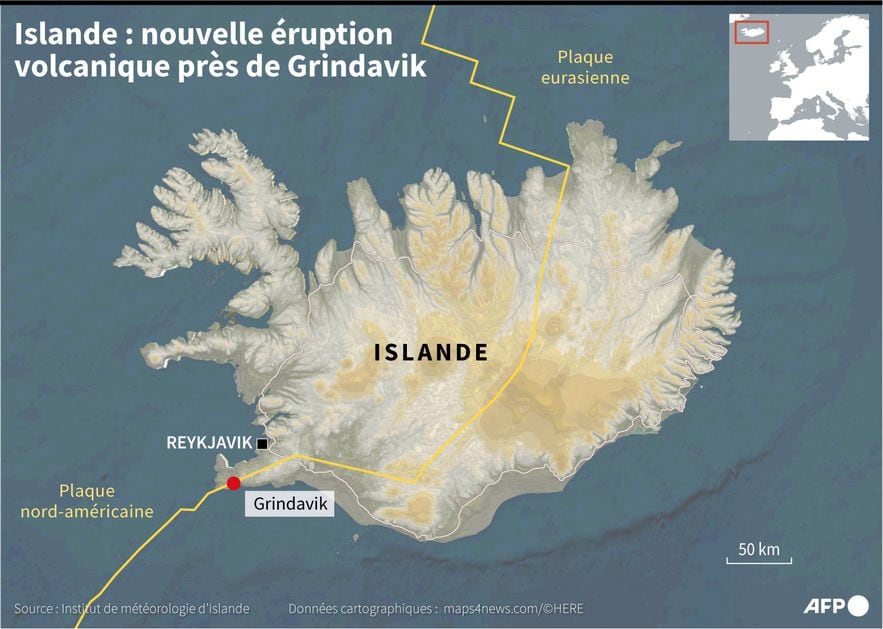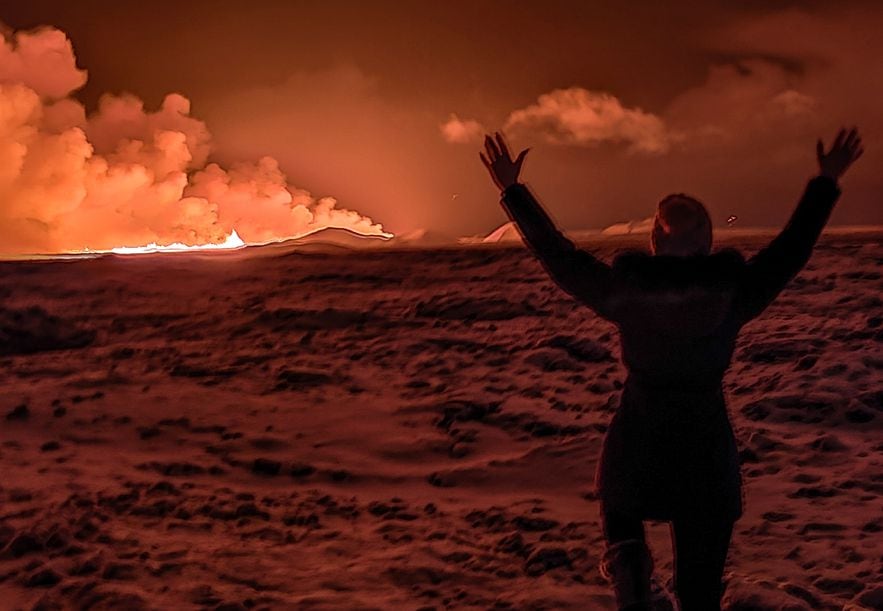Geysers of molten lava continued to light up the Icelandic sky on Tuesday, December 19, the day after a new volcanic eruption occurred southwest of Reykjavik after weeks of seismic activity. This new eruption, the fourth in two years, took place three kilometers from a small town of 4,000 inhabitants, Grindavik, evacuated since November 11 after the declaration of a state of emergency in the region following a significant accumulation of magma.
L’Express takes stock of the situation, and the risks posed by this eruption described by specialists as “one of the most spectacular ever observed” in the country.
What happened ?
Volcanic eruption on the Reykjanes peninsula, near Grindavik, December 18, 2023 in Iceland
© / afp.com/Kristin Elisabet Gunnarsdottir
The eruption began on Monday, December 18 at 10:17 p.m. (GMT) following an earthquake around 9 p.m., according to the Icelandic Meteorological Institute (IMO). Live-streamed footage of the eruption shows jets of bright orange lava spilling from a fault, surrounded by clouds of red smoke against the dark morning sky. “Our thoughts go […] to the local population (Editor’s note: from Grindavík), we hope for the best, but it is clear that this is a considerable eruption”, wrote the head of the Icelandic government, Katrín Jakobsdóttir, on Facebook.
The fissure is about four kilometers long, much longer than during the last eruption of the summer. “We now wait to see what the forces of nature have in store for us,” Icelandic President Gudni Johannesson wrote on X (formerly Twitter). He added that protecting lives and infrastructure was the priority. At one point, between 100 and 200 cubic meters of lava were emerging per second.
The eruption had been expected for some time. In October, signs of swelling of the ground were detected near the “Blue Lagoon”, famous hot baths with turquoise waters very popular with tourists. The site partially reopened on Sunday.
What are the risks ?
The Svarstengi geothermal power plant is two kilometers west of the eruption and provides electricity and water to around 30,000 residents in the area. Authorities built a protective wall around the facility after seismic activity in November. All roads around Grindavík are closed and are expected to remain closed for the next few days, police announced on Facebook, specifying that the population is in no danger in the current state.

Iceland: new volcanic eruption near Grindavik
© / afp.com/Sophie RAMIS, Sylvie HUSSON, Jean-Michel CORNU
The power of the eruption “seems rather to be decreasing”, reassured the IMO on its website this Tuesday morning. “That activity is already decreasing is not an indication of the duration of the eruption, but rather that the eruption is stabilizing,” adds the institute. According to the IMO, the aviation color code had changed to red, before quickly returning to orange in the absence of an ash cloud. “For the moment, there is no disruption to arrivals or departures at Keflavik airport,” Icelandic airport operator ISAVIA said overnight on its website, with traffic being relatively low at this time. late.
In 2021, 2022 and last July, volcanic eruptions, in an uninhabited area nearby, had become major tourist attractions, attracting nearly 680,000 visitors, according to the Icelandic Tourist Board. The head of civil protection and emergency management in Iceland Vídir Reynisson warned that this new eruption “is not a tourist eruption and you have to observe it from very far away”, on local public television RUV.
A new volcanic cycle?
Until March 2021, the Reykjanes Peninsula, south of the capital Reykjavik, had been spared from eruptions for eight centuries. Since then, there have been two others, in August 2022 and July 2023, a sign, for volcanologists, of a resumption of volcanic activity in the region. According to volcanologists, the new cycle in the peninsula could last decades. Thirty-three volcanic systems are considered active in this country of fire and ice, the most volcanic region in Europe.

A resident watches smoke coming from a crack on the Reykjanes Peninsula, south of the capital Reykjavik, Iceland, December 18, 2023
© / afp.com/Kristin Elisabet Gunnarsdottir
On November 11, the residents of Grindavik were evacuated as a precaution after hundreds of earthquakes caused by the movement of magma under the earth’s crust, a potential warning sign of a volcanic eruption. Buildings and roads in the city were extensively damaged by this seismic activity. “No country is better prepared for natural disasters than Iceland,” the Prime Minister said on November 18.
In 2010, the Eyjafjallajökull volcano, in the south of the island, caused the greatest disruption to air traffic in peacetime. A title since erased from the shelves by the Covid-19 pandemic. Other volcanoes, such as Askja in Iceland’s uninhabited central highlands, have recently shown signs of activity.
